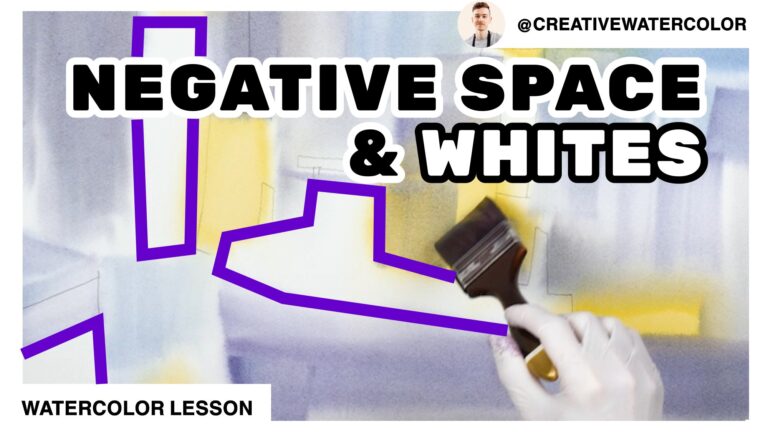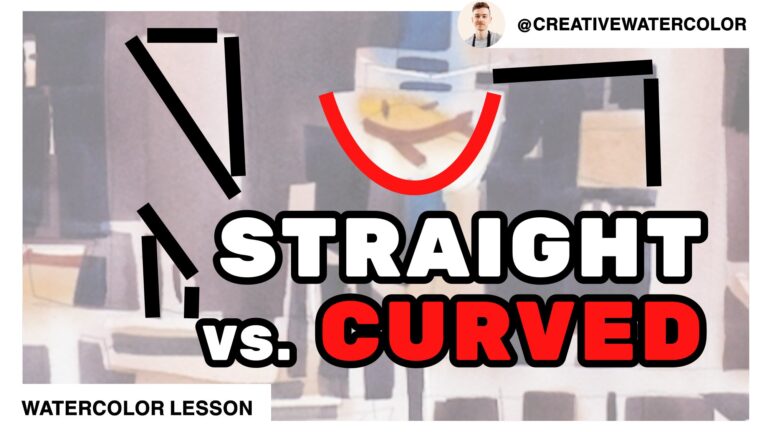Best way to fix weak watercolors – seaside town demo 3 of 3. Find out in this watercolor lesson what makes for weak watercolors and the best way to fix them.
Hello everybody, welcome back to my studio!
I hope you’re enjoying the process of seeing this painting develop from start to finish. In today’s video we’re completing the painting by adding two final layers: 1. dark-middle value – to further define form, and 2. darks – to increase depth and enhance contrast.
In the last video we talked about connected washes and how they help increase the sense of unity. The purpose of the next wash is to create separations and distinctions of objects and other symbols in the painting and establish proper form. Objects are rendered with value. Where there is a change of plane, a change of value is necessary. This is basic modeling.
I want you to notice a couple things as I apply this wash. In terms of color notice how I treat the wash, once again, as an overall pattern of warm and cool. Even though the variation is subtle, it’s enough to convey a sense of depth. And this is one of the functions of color in a painting. Choose color not because it was there in the scene but because it fulfills a purpose in your painting. That is not to say there’s anything wrong with using a naturalist palette. But even the best naturalist painters adjust their color to work for their painting too, they don’t just mechanically copy what they see in their reference.
Finally, remember to make the value of this wash dark enough so that it clearly differs from the previous layer. Enough contrast is necessary to show off the change of direction of your planes. Alwyas aim for gradual increase of value. If you happen to understate this wash you can still simply go back once it dries and paint over it again, though that will lose you some color intensity – but it’s still better than leaving too big a gap in your value range.
Now we’re coming to the actual theme of today’s video. What is the best way to fix weak watercolors? The best way to fix weak watercolors is to make sure your painting makes use of full value range. We often see beginners stop somewhere around middle value and then add a couple dark touches at the end. This leaves a huge gap in their value range and as such, the painting lacks body and substance. Visual substance.
It’s much more common to see works that lack proper lower value range – that is they’re deficient in dark middle values and darks. Darks are extremely important, but watercolorists often understate their darks, and I think it’s partially because of the transparent nature of the medium. Lacking proper value contrast and wide value range leads to unsatisfying visual experience. Our vision is based on contrast. We perceive separation when light things stand against dark ones.
We discussed the what and the why, the only thing left is to discuss the how. In terms of the bigger picture, try to place your darks so that they are spaced around the work and as a whole create a balanced pattern.
When working with darks, don’t be afraid to use them boldly. Don’t use your darks as little spots and dabs. The dark value shapes greatly help with depth in composition. Use them to indicate which shapes come forward by simply placing darks next to them. Remember: dark shapes recede, light shapes come forward.
As for the mixing of your darks, it only makes sense to mix darks using the darkest paints on your palette. Don’t use black though and don’t use any dark paint that’s not highly transparent. Paints like Permanent Alizarin, Phthalo Blue, French Ultramarine and Phthalo Green are perfect examples of transparent paints that make for strong and sparkling blacks. Let’s not forget that even darks should be varied. Play around with the ratio of these dark paints to create mixtures that are warmer or cooler.
Finally, at this final stage of adding some details I’m using a brush that I didn’t mention at the start of our demonstration. This is a ‘Rosemary & Co Pure Sable Series 90’. It’s a brush that is primarily used for lettering and calligraphy. It’s only fitting that the brush should work well for calligraphic marks in a painting scenario.
And that’s all for today. I hope you enjoyed the painting and this new format. Please let me know how you liked it, leave any questions, comments or requests in the comment section below the video and I hope you’ll join me next week!




